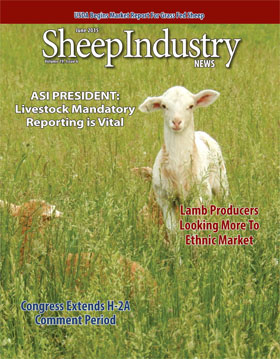
- June 2015
- President’s Notes
- Congress Extends H-2A Period
- Theos Family Reaching Niche Lamb Market
- Market Report
- Australian Wool Market Rallied; U.S. Gains
- USDA Begins Releasing Grass Fed Report
- Clark Willis Obituary
- Region IV Bighorn Plan Implemented in Utah
- Western Lawmakers Team to De-List Wolves
- ASI Photo Contest
- ASI Supports COOL For Lamb
- Battle Not Over in Sage Grouse Fight
- Livestock Mandatory Reporting
- No Grazing This Summer
- Separate Efforts: Scrapie Eradication Program and the Animal Disease Traceability Program
- Lamb Producers Look to Ethnic Groups
- Study Explores Disease in Grand Canyon Bighorns
- Sheep News In Brief
Battle Not Over, But Small Victory in Sage Grouse Fight
In a decision that could reverberate across the West, the Obama administration announced that it will not designate a small population of greater sage grouse in Nevada and California as threatened or endangered.
While the announcement by Interior Secretary Sally Jewell affects only an area of about two million acres straddling the two states, some see it as a signal her agency won’t move to list the species as endangered in a habitat spanning 165 million acres in 11 Western states.
Such a listing, many businesspeople in the West fear, would lock up land from ranching and other activities and cripple the region’s economy.
“That was wonderful,” Nevada sheep rancher Fred Fulstone, who has grazed sheep for more than 70 years and been involved in the efforts regarding listing of the sage grouse, said after hearing the news.
Darrell Pursel, Mason Valley farmer and president of the Lyon County Farm Bureau, said the announcement was good for those who graze in the areas where the bi-state live, but added it was too bad it didn’t include the whole greater sage grouse, which lives in 11 western states.
In one of those states – Colorado – the National Wildlife Federation and other hunting and fishing groups urged Colorado Gov. John Hickenlooper to issue a strong executive order supporting protection for the imperiled greater sage-grouse, which he did on May 15. Hickenlooper’s order designates habitat exchanges as the preferred compensatory mitigation option for companies impacting greater sage-grouse habitat in the state.
“This executive order underscores the need and opportunity for Colorado agriculture and industry to contribute to the state’s sage-grouse solution,” said Eric Holst, senior director of working lands at Environmental Defense Fund.”
The executive order gives Colorado farmers and ranchers the opportunity to enroll in the Colorado Habitat Exchange to earn new revenue for improving greater sage-grouse habitat sold to energy companies and other developers looking to mitigate impacts.
The Exchange “will unlock new opportunities for farmers and ranchers to make sagegrouse conservation a part of their business models,” Holst said.
Colorado has 31.3 million acres of private working lands.

